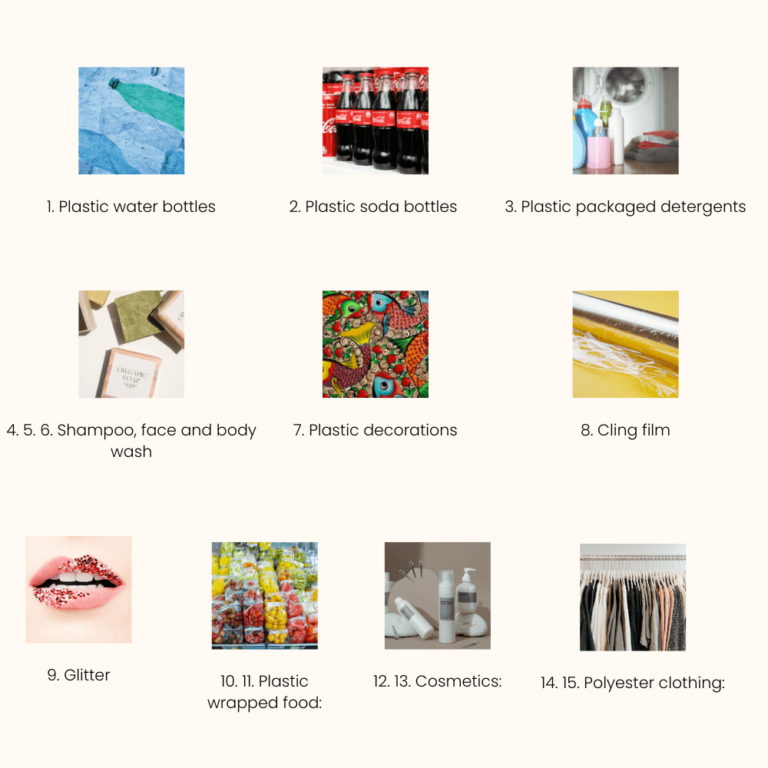How to stop using plastic?
A challenge to reduce, replace, and stop using plastic as a customer.
“By removing these 15 items from your shopping cart you will decrease your plastic consumption by an average of 20 kg/year. By weight, that is the equivalent of 1,000 small plastic water bottles!!”
Let’s get straight to it!
What impact would we make collectively if we stopped using 15 plastic and plastic packaged items that we use in our day to day? This is a challenge that I invite you to take part in! I will share a list of products I recommend and find easy to replace.
How easy it is to replace these items will vary depending on your habits and where you live; what is available to you. Sustainable products have become synonymous with spending more money, but you will see that these changes don’t have to cost more as you find out how to re-prioritize environmental needs. Cost saving (majority) replacements will be highlighted in the list.
Will your actions make a difference?
Up to 65% of solid waste comes from households. So, replacing these items is as well targeted as it gets. Not only will it stop generating waste that will go to landfill, but it will also prompt the producing companies to find sustainable/circular/regenerative solutions to keep you as a customer. Click here to see how you can further prompt businesses to do better.
It’s important to note that 40% of plastic waste comes from packaging so avoiding plastic packaging is a sure way to greatly decrease your plastic footprint and will be included in this list.
Your actions count! Our actions are directly causing this plastic pollution situation.
I will add that this is likely to be a process, and may take some time to find new products that suit you.
When you use the plastic footprint calculator and share your progress with us, we will be able to measure how much plastic we avoided all together. I find this very exciting! Do you?

By removing these 15 items from your shopping cart you will decrease your plastic consumption by an average of 20 kg/year. By weight, that is the equivalent on 1,000 small plastic bottles!!
My list for this challenge.
1. Plastic water bottles: Replace with reusable bottles, use one that you already have if possible, a used glass or plastic bottle perhaps? (cost saving)
2. Plastic soda bottles: Replace with aluminum, glass, or stop drinking soda- it’s not that great! (cost saving)
3. Plastic packaged detergents: Use solid, powder, or non plastic packaged detergents available to you. (can be cost saving with traditional products, or slightly more expensive with eco brands)
4. 5. 6. Shampoo, face and body wash: use shampoo, soap, and conditioner bars (equally priced,or slightly more expensive for eco brands)
7. Plastic decorations: completely stop buying decorative plastic items, holiday decorations included. You might find that you will be buying a lot less items as you make this change because of availability. You can then use the money saved on second hand or possibly more expensive durable decoration that is sourced from natural materials and small vendors that will last longer and have better second hand value. Because the values of these items will vary greatly, it is not included in the 20 kg/year estimate. You can however use the calculator to track your progress under “Toys, furniture, etc“.
8. Cling film: is just a badly designed product that cannot be reused, repurposed, or recycled. Replace with silicone covers, glass containers, or just use a plate to cover your food! Initially might have a higher cost if you choose to buy containers or silicone covers, but in the long run you are saving. (Using a plate is cost saving!)
9. Glitter – I won’t even say anything here.. (Cost saving)
10. 11. Plastic wrapped food : Replace 2 items that you buy regularly and substitute them for package free. Remember to take a reusable container or bags when you go shopping (Can be either cost saving or slightly more expensive depending on the item you choose and availability).
12. 13. Cosmetics: Replace 2 plastic packaged items. It is also likely that there are products you don’t actually need, select these items and don’t buy them again (Can be either cost saving or slightly more expensive depending on the brands you choose).
14. 15. Polyester clothing: Replace and avoid buying clothing made from polyester (recycled polyester included). Use sustainably sourced and compostable natural fibers instead like cotton, linen, viscose(non -treated), and wool. These products are more expensive, to make sure you are shopping sustainably, buying less clothes is important making it cost effective! Also, secondhand value is better for high quality items. Start by avoiding buying 2 polyester items on your shopping list for this challenge. Because the values of these items will vary greatly, it is not included in the 20 kg/year estimate. You can however use the calculator to track your progress under “Toys, furniture, etc“.
Why stop using plastic?
- An average of only 9% of plastic gets recycled.
- Recycled plastic is more likely to leach into its surroundings.
- Plastic causes many health issues like cancer.
- Plastic pollutes wildlife habitat and kills animals.
- To prompt producers to find alternatives making sustainable materials and business practices more feasible.
How to join this challenge?
Fill in the form to start the challenge. The duration of this challenge is 3 months. You will do your best to avoid using the 15 items mentioned in the list. Use the calculator to measure your footprint if you’d like to, as well as earn badges. Of course, it would fantastic if you choose to continue to avoid using these products after the challenge is over and continue to share your stories with us! When you sign up, we promise not to send you tons of email marketing and only send you updates on this challenge.

About the Author: Lara Mehanna
I’m a circularity and regenerative business consultant, trainer, and instructional designer. I work with SMEs on designing out waste and improving business experience. My story with sustainability started between kitchens and local farms over 10 years ago. I have had the privilege of establishing and assisting with the development of many green businesses in the areas of product design, arts, farming, and hospitality. You will find many more of these examples and applications in my courses and training programs.
Who is taking part?
This text briefly introduces visitors to your main services.

Service 1
A short description of the service and how the visitor will benefit from it.

Service 2
A short description of the service and how the visitor will benefit from it.

Service 3
A short description of the service and how the visitor will benefit from it.

Service 4
A short description of the service and how the visitor will benefit from it.
